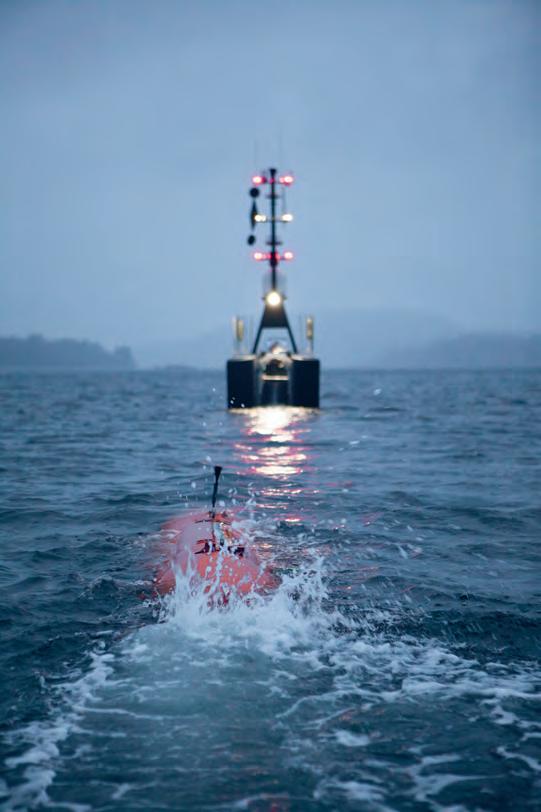
7 minute read
The Global Transition to Remote and Autonomous Operations
The Benefits and Challenges Facing the Maritime Industry
Over the next five years, we will witness a significant reduction in the maritime industry’s reliance on larger vessels, as the focus on compact and agile uncrewed surface vessels (USVs) increases and a wider transition towards remote marine operations continues to gather momentum. The benefits as well as the legal framework challenges of remote and autonomous operations will have a profound impact on the energy and maritime industries.
The ability to plan, manage and monitor offshore projects, and maintain assets and infrastructure, through remote operations and autonomous capabilities is increasingly critical within the energy and maritime industries. Through their flexible deployment and good connectivity with onshore remote operations centres (ROCs), USVs can acquire data to support these objectives faster than ever before.
Safety and SuStainability
USVs also provide significant benefits when it comes to safety: used as force multipliers alongside crewed parent vessels, they allow crewed vessels to remain at a safe distance from assets such as wind turbines and avoid unnecessary risk for those onboard. This has the potential to translate into a 100% reduction in human exposure to hazardous offshore environments where, rather than transmitting their situational awareness and vessel status data to personnel onboard parent vessels, USVs will ultimately be solely controlled from the safety of an onshore location, such as one of Fugro’s ROCs.
Additionally, clients are increasingly looking to reduce the environmental impact of their
Fugro’s Blue Shadow next-generation uncrewed surface vehicle.
operations in line with the zero emission targets presented in the UK Government’s Maritime 2050 route map. The global transition towards remote and autonomous working will help reduce the greenhouse gases emitted by the maritime industry, as hybrid USVs consume up to 95% less fuel than conventional vessels. However, despite these obvious advantages, as innovation outpaces regulation, the legal framework in which USVs operate remains a challenge.
MaritiMe legiSlation for uncrewed VeSSelS
The safety of life at sea is a core value of all maritime authorities around the globe. The current maritime legislation has been carefully crafted over decades with the safety of the mariner at its core; however, we are now transitioning to a future where vessels no longer have a mariner onboard, which creates a gap in the current legislation. This poses an interesting problem of how to legislate for both crewed and uncrewed vessels operating side by side.
Safety StandardS
As is the case with the rapid development of any new technology, it is challenging to create fixed ruling that leaves room for constant innovation and the continued progression of new methods of working.
One of the first attempts at this will be the revised workboat code being developed by the Maritime and Coastguard Agency (MCA), expected by the start of 2022. The workboat code document will apply to commercial vessels up to 24m long and include new regulations covering Maritime Autonomous Surface Ships. This reflects the fact that many USVs in development or already operating are smaller than their conventional crewed vessel counterparts.
The focus of this forthcoming legislation is expected to shift from the safety of crew onboard to the safety of other seagoing vessels and the wider environment. This is particularly the case with the adoption and creation of rules to ensure vessels can maintain an awareness of their surroundings and take appropriate action to prevent incidents. At present, vessels have two clear ways to achieve this: through remote monitoring and control by a human operator and/or using onboard situational awareness and collision avoidance software.
truSting uncrewed and reMote tecHnology
Much like self-driving cars, societal acceptance is crucial to the adoption of these new technologies, where they are expected to work correctly 100% of the time with no margin for error. While collision avoidance systems are being developed to improve USVs’ navigation safety, the question of public trust remains: can we trust a USV to be left alone at sea and respond as a conventional crewed vessel would? If not, how do we ensure that the people who are remotely monitoring and controlling them have the same situational awareness as they
Fugro’s Blue Shadow hydrographic survey operations displayed onscreen in a Fugro remote operations centre.

would onboard? The regulations which eventually come into force will need to balance the developmental freedom to truly revolutionize the way in which the maritime industry operates with the ongoing protection of those human lives still at sea, while also improving safety standards and protecting the environment.
trialled and teSted uSV oPerationS
Fugro’s Blue Shadow is a globally deployed, next-generation 9m autonomous and uncrewed hydrographic survey platform delivering nearshore seabed insights faster. Part of Fugro’s overall hydrographic solution, Blue Shadow is one of many from its fleet of USVs ranging from 9m to 24m, within the suite of remote and autonomous capabilities that are more sustainable when compared to conventional vessels. Sustainability of USVs is an advantage built into their design concept from the beginning: vessels whose function is purely to survey and acquire data can of course be much smaller than traditional vessels, which are designed to transport people and cargo. Fugro recently completed its first remotely operated hydrographic survey using Blue Shadow to capture hydrographic and bathymetric data to support safe navigation, nautical charting, marine site characterization and resource management activities. Executed during challenging environmental conditions, including waves of up to 2m, the compact, wave-piercing design of the USV allowed it to acquire high-quality data in conditions that would have been unworkable for conventional vessels. This lengthening of the potential work window increases surety of project delivery, providing more opportunities throughout the year to acquire much-needed data for clients.
The survey operations also achieved, depending on the sea conditions, a 61% to 96% reduction in greenhouse gas emissions through significantly reduced fuel consumption. Moreover, the innovative collision avoidance and advanced spatial awareness technology built into the Blue Shadow ensured its autonomous operations met the highest safety standards.

wHat next?
While the development and deployment of new remote and autonomous solutions progress, the legal framework will continue to play an essential role in influencing the design and engineering parameters for next-generation USVs and other Maritime Autonomous Surface Ships. We are currently in a critical phase of the global transition to remote and autonomous maritime operations and it is essential that the legal framework is swiftly put in place to allow these technologies to flourish.
Fugro’s Blue Essence USV, part of Fugro’s remote and autonomous operations solution, carrying out inspection operations.
Fugro’s Blue Shadow performing its autonomous survey trials off the coast of Portchester, UK.

Hugh Parker is the product owner for Fugro’s uncrewed surface vessels for hydrographic services. He has a degree in Geoinformatics and Surveying, and a postgraduate diploma in the FIG/IHO category A certified course specializing in Hydrographic Surveying. Also an experienced business development manager, Hugh has managed hydrographic survey services for Fugro worldwide. Hugh Parker and Ross Macfarlane, Fugro h.parker@fugro.com
Ross Macfarlane Since coming ashore, Ross has embedded his training and safety experience into his work with future technologies. His current position as USV Policy and Public Affairs Advisor at Fugro sees him leading the regulatory affairs for Fugro’s new autonomous vessels and developing the human/ machine relationship by reshaping the workforce’s skill set. r.macfarlane@fugro.com

High-performance Airborne Bathymetry


The Leica Chiroptera 4X and HawkEye 4X bathymetric LiDAR systems provide unprecedented water depth penetration and seabed object detection even in turbid waters. The system is scalable, collects seamless data from water to land and leverages the Leica LSS 3.0 endto-end processing workflow for LiDAR calibration, refraction correction, point cloud classification, data enhancement and visualisation.




leica-geosystems.com/chiroptera-4x


Leica Geosystems AG leica-geosystems.com

SMART SUBSEA SOLUTIONS
Delivering data in most adverse conditions: underwater acoustic modems with advanced communication technology and networking






